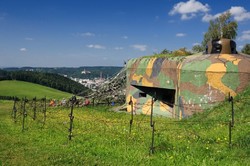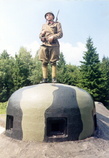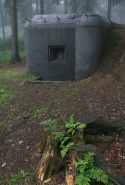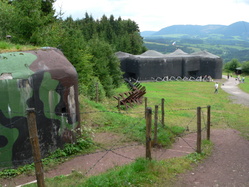Homepage › Landmarks › Fortresses
Fortifications from the period of the first Czechoslovakian Republic
After Hitler came to power in Germany, the First Czechoslovak Republic got into the mortal danger. The army had to prevent a sudden military incursion across the border into the interior and the country division so that Czechoslovakia has at least some chance in the future military conflict with the much stronger enemy.

The intention of military command was to build a continuous line of objects made of reinforced concrete, and armed with machine guns and cannons that would cover each other by the side firing. The zone of the light and heavy fortification strengthened in the most critical points by the so-called artillery strongholds was supposed to protect the whole border of Czechoslovakia. Despite the frenzied pace of fortifications building in the years 1935 to 1938 the original plans were not accomplished. Nevertheless nearly 10,000 light and 265 heavy objects were almost completed and nine artillery strongholds were started to build. The strongest fortifications should have been built mainly on the northern border with the then German Silesia, from the Krkonoše Mountains to the region around the city of Ostrava. That is why it is not coincidence that there are many of up to date preserved objects in the area of the Hradec Králové Region.
The fortification was built with great zeal and though unfinished, it was occupied by Czechoslovak soldiers who were ready to defend their country against the fascist danger. By the infamous Munich Agreement signed on 30th September 1938, the European powers forced Czechoslovakia to withdraw from the borderland inhabited mainly by Sudeten Germans. The Czechoslovak government, betrayed by its own allies – France and Great Britain, was forced to give up the borderland with fortifications in favour of Germany in order to "save the peace in Europe". The path to the World War II was opened.

No one is able to imagine feelings of disappointment of soldiers´ who had to leave the border fortifications humiliated without the fight. After occupying the Sudetenland the German army tested the weapons and tactics on the gained fortifications but without much success. At least reinforced cupolas and embrasures were extracted from the number of fortifications. Abandoned buildings were decaying even after the War. In 1969 the fortress Dobrošov was declassified and was the first which was open to the public. After the year 1989 there are hundreds of fans who repair and make accessible other fortifications in order to remind the others of unfulfilled dreams of the builders and the commitment of its defenders, but also the betrayal of Czechoslovak nation. Volunteers of military history clubs not only spend plenty of time on repairs but also put their funds in it. It enables opening of the wide range of museums in border fortifications and their rescue and access for next generations.
Light objects

The Light object model 37 - the famous "řopík". After experiments with the model 36 model 37 was accepted as a standard universal model for the objects of light fortification, designed in several variants (model 37 A, B, C, D and E). This bunker for three to seven soldiers was assigned to lead mostly side machine gun firing, towards other similar objects. Only a continuous strongest wall of the fortress protected by the stone backfill was exposed from the side of the enemy attack. The arrangement of buildings with firing to sides prevented the enemy from artillery firing against embrasures or entrance. A brilliant fortress was supposed to withstand a direct hit of the artillery grenade up to the calibre of 100 mm.
These objects were built in continuous lines, at a distance of 150-400 m apart, in In unaccessible terain only one line was built, in an open field two and in critical areas up to four lines.
A popular name "řopík" comes from the abbreviation of headquarters of fortification works, which was in charge of building fortifications. We can find hundreds of those objects in the Orlické and Jestřebí Mountains and at the ridges of the Krkonoše Mountains.
Heavy objects

The same as “řopíky” heavy objects should have executed side firings. A continuous line of heavy fortification should have held on a long-term basis the movement of German troops into the interior. The so-called infantry casemate for 10-40 soldiers was the main feature of the heavy objects, armed with heavy machine guns and cannons, which should have executed side firings. The bunker usually had one underground floor, with quarters of troops, generating set, ventilation filters and stores, and one floor above ground with the shooting rooms. Firing should have been conducted by the embrasures, the reinforced cupolas in ceilings of the bunkers were used mainly for observation. The bunkers had a number of technologically resolved facilities, which included wells, systems of ventilation and even at that time unusual flushing toilets.
The soldiers had a sufficient supply of ammunition and food for 14 days. Top class bunkers were able to withstand the artillery fire up to the calibre 420 mm while the vast majority of German army weapons available at that time had about ten times smaller calibre.
Infantry casemates can be today found as the part of artillery forts or as a stand-alone bunkers in the line of heavy fortifications - for example in the so-called enclosure of the Jestřebí Mountains (at Odolov), in Náchod (Březinka), or close to Rokytnice v Orlických horách.
Artillery strongholds

For the conducting of direct heavy artillery firing on the advancing enemy troops the so-called artillery forts have been established. They were the groups of bunkers made of reinforced concrete allowing a circular defense. Besides infantry casemates there were specific objects like artillery casemates for long-range quick firing howitzers, or artillery and mortar turrets. All bunkers were interconnected by an extensive system of underground tunnels with storage rooms and quarters. Artillery forts should have been protected by hundreds of soldiers who could have defended even in a full encirclement for several weeks.
The heavy line of Czechoslovak fortification from Trutnov to Ostrava had to contain 13 artillery fortresses of which seven should have been in the area of Hradec Králové Region. The most massive artillery fort Babí (Stachelberg) close to Žacléř was supposed to fire at the enemy 243 shots per minute using ten howitzers.
Not even one artillery forts was ever finished (construction of artillery fortress Jírova hora and Poustka was not even started);. Artillery forts Hanička and Skutina in the Orlické Hory Mountains, Dobrošov close to Náchod and Babí (Stachelberg) close to Trutnov are accessible to the public in the Hradec Králové Region.
Pevnost Babí (Stachelberg) - Babí fortress (Stachelberg)
From the planned largest stronghold of Czechoslovak fortifications a single object, infantry blockhouse T-S 73, was erected. There is an exhibition dedicated to the fortifications, and part of the underground area of the stronghold and “řopík” (infantry blockhouse) vz.37 type A-160 are also accessible.
Pevnost Dobrošov (Dobrošov fortress)
The stronghold has been accessible since 1969 - artillery cabin N-S 75 "Zelený" (Green), infantry blockhouse N-S 72 "Můstek" (Small Bridge) and part of the adjacent underground (ammunition dump, barracks). In the operations building there is a permanent exhibition dedicated to the Czechoslovak army of the First Republic.
www.pevnost-dobrosov.kvalitne.cz
Pevnost Hanička (Hanička fortress)
Artillery stronghold from the 1930s reconstructed in the 1980s into a nuclear bomb shelter and a modern command station. The underground stronghold, and artillery and infantry blockhouses are accessible. In the entrance building there is an exhibition of weaponry and technology.
Pevnost Skutina (Skutina fortress)
One of the two completed objects of the stronghold has been accessible to the public since the year 2000 - infantry blockhouse N-S 48 “U stodol” (At Barns). In addition to the tow-storey object, it is also possible to take the stairs to the extensive underground bunker and watch the progress of the renovation of the underground corridors.
Infantry blockhouse N-S 84 “Voda”
The newly opened building of heavy fortification is a part of "Běloves fortress museum." The exposition with the unique exhibits of weapons, uniforms and equipment is complemented by video projections. The blockhouse is easily accessible from the shopping centres in Náchod-Běloves. Thanks to its positions and the fact that it is the unique, only one-story building, it is completely wheelchair accessible.
Infantry blockhouse N-S 82 “Březinka“
The heavily fortified object above Náchod is in a complete working order, including original cannon. The project "Běloveský fortress open air museum" presents a comprehensive layout of heavy and light fortifications from parts of the border defenses.
Infantry blockhouse N-S 71 “V sedle” (KAHAN III)
The infantry cabin near the fort Dobrošov had a remarkable fate. The object of pre-war fortification was, in connection with the construction of the anti-nuclear shelter Hanička, reconstructed under the code name Kahan in the years 1986-1989 to become the connecting centre of the secret State Security Ministry of the Interior. Currently there is a Museum of the Cold War operated by the Club of the Czechoslovak Fortification “Montace”.
Infantry blockhouse T-S 27 “Nad cestou“
Free standing infantry blockhouse with level 1 protection. The object has been preserved in a very good state. Reconstruction work has been underway since 1998. Despite the fact that the work is far from over the object is open to visitors.
Infantry blockhouse T-S 26 “Odolov”
A two-sided free-standing infantry blockhouse with level 1 protection close to the village of Odolov in the mountainous massive of the Jestřebí Mountains. The object is still under reconstruction and there is also a small military history exhibition of documents, munitions and weaponry under preparation.
Infantry blockhouse T-S 20 “Pláň“
A free standing blockhouse with level 2 protection near the village of Chlívce, towards Červený Kostelec. In the object there is a museum dedicated to World War II, with numerous exhibits of period equipment and munitions. There is also a memorial to the victims of the fight for freedom in Czechoslovakia between 1938 and 1945.
Infantry blockhouse T-S 19 “Turov”
The infantry blockhouse in the Jestřebí Mountains separated, together with the adjacent blockhouse T-S 20, the road Stárkov – Červený Kostelec. During the German occupation resistance tests were carried out on the building, therefore it was severely damaged. Currently the blockhouse is undergoing extensive refurbishment, which is financed by the local military history club. Tours by appointment.
Infantry blockhouse T-S 5 “U křížku“
A gradually reconstructed object with an exhibition dedicated to Czechoslovak fortifications, the Czechoslovak army and the fate of airmen and airplanes of World War II.Erected in 1937 on the eastern edge of the Jestřebí Mountains, on the right wing of the planned artillery stronghold of Jírova Hill.
Infantry blockhouse N-S 74 “Na Holém”
Infantry cabin is located directly next to the car park by the artillery fortress Hanička; therefore one can visit both. During the Munich crisis the blockhouse was fully equipped and armed with anti-tank guns and machine guns. Although the inner part is inaccessible, the blockhouse is worth seeing due to its exceptional preservation. The blockhouse has also well preserved anti-tank ditch and a system of anti-tank obstacles was reconstructed.
Light object vz.37 in Babí by Náchod
Light object vz.37 type D2. The blockhouse is put into a state from 1938 – the interior is fully equipped with internal equipment including munitions. Tours usually take place in period uniforms.
Light fortification in the Jestřebí Mountains
The lines of light fortifications were located along the border. You can visit the preserved and reconstructed objects type 37 in the Jestřebí Mountains, between Zbečník nearby Hronov and Odolov, where in the second sequence they were accompanied by heavy fortifications. Renovated objects are located for instance near the infantry blockhouse T-S 20 “Pláň” where an anti-tank ditch and trenches connecting individual objects are preserved.
Light fortification in the Orlické Mountains
If you visit the Orlické Mountains, it is impossible not to notice the concrete objects of the Czechoslovak fortification. Apart from the great famous fortresses on the ridges, there are also hidden hundreds of light bunkers in the forests which were built in several sequences. Many of them are already open for tours or are being prepared to be opened for visitors.
Photogallery
-
pevnost Skutina
-
lehký objekt vz.37
-
 pěchotní srub Březinka
pěchotní srub Březinka -
 pěchotní srub Březinka
pěchotní srub Březinka -
 pěchotní srub Březinka
pěchotní srub Březinka -
 pěchotní srub Březinka
pěchotní srub Březinka -
 pěchotní srub Březinka
pěchotní srub Březinka -
 pevnost Dobrošov
pevnost Dobrošov -
pevnost Babí (Stachelberg)
-
 pěchotní srub Březinka
pěchotní srub Březinka -
pevnost Hanička
-
pevnost Skutina
-
pevnost Skutina
-
pevnost Skutina
-
pevnost Skutina
-
 pěchotní srub Odolov
pěchotní srub Odolov -
 pěchotní srub Odolov
pěchotní srub Odolov -
 pěchotní srub Odolov
pěchotní srub Odolov -
 pěchotní srub Odolov
pěchotní srub Odolov -
 pěchotní srub Odolov
pěchotní srub Odolov -
 pěchotní srub Odolov
pěchotní srub Odolov -
 pěchotní srub Odolov
pěchotní srub Odolov -
 pevnost Hanička
pevnost Hanička -
 pevnost Dobrošov
pevnost Dobrošov -
 pěchotní srub Březinka
pěchotní srub Březinka -
 pevnost Babí (Stachelberg)
pevnost Babí (Stachelberg) -
 pevnost Dobrošov
pevnost Dobrošov
![Hradec Králové Region [logo]](/images/khkrajcr/kralovehradecky-kraj-en.jpg)